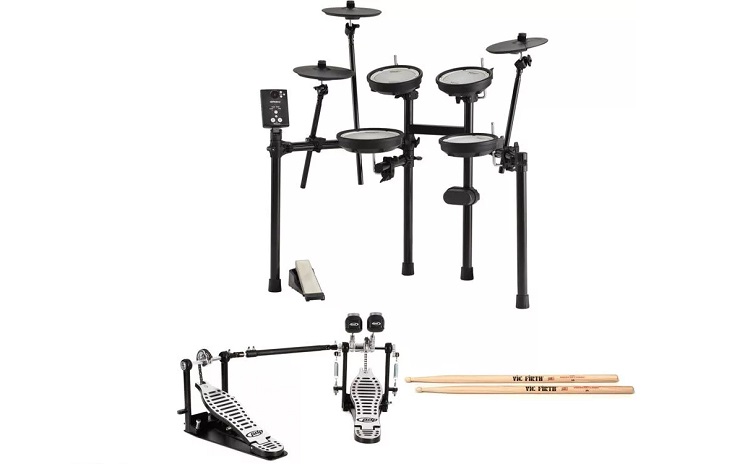- Lights, Camera, and Action: How to Film and Edit a Drum Cover - May 31, 2022
- The Best Wuhan Cymbals: A Comprehensive Buying Guide - May 30, 2022
- Alesis Surge vs Command Compared - April 26, 2022
The topic of double bass comes up quite frequently amongst drummers who play rock and metal music. Using double bass drums or pedals requires a certain level of skill, of which only a handful of drummers dare to learn. The sound of the double bass is mostly favored by musicians who are into aggressive and complex rhythmic bass patterns.
As many players don’t find double bass relevant to the music they play, only a select few drum companies have invested their time and resources into electronic drum kits with a double bass. In turn, this has driven drummers to come up with innovative techniques to incorporate double bass pedals into their setup.
Some drummers tend to use bigger kick pads, which can house two beaters and a double bass pedal. One of the biggest drawbacks of using double bass pedals on some electronic drum kits is that the drum module is not fast enough to register faster double bass notes. This is certainly a factor you should look into if you’re planning on playing music at high tempos.
We’ve put together a list of some of the best electronic drum kits for double bass to suit a wide range of budgets and ability levels. Whether you’re a beginner who is about to enter the world of double bass drumming, or you’re an advanced player who’s looking for a drum kit with the most advanced features, we’ve got you covered.
Why Use a Double Bass Drum Pedal?
Double kick pedals are almost a no-brainer in some sub-genres of metal (such as Thrash Metal, Speed Metal, and Death Metal) while still holding a near and dear place in the underground electronic music scene. The use of double bass drums is mostly subjected to the complexity of drumming patterns, which is why they are quite popular in rock, some forms of jazz, and fusion music too.
There are two ways to set up an acoustic kit to play double bass drums:
- Have two actual separate bass drums
- Get a double bass pedal
Many drummers usually prefer the latter, as having two separate kick drums takes up a lot of floor space. It also adds a substantial amount of weight to the kit too.
Brief History of Double Bass Drums and Pedals
Jazz legend Louie Bellson was among the first to envision the idea of double bass drums. He sketched out a double bass drum kit for his art class at the age of 15, which earned him an “A” grade. After getting rejected by multiple companies, Bellson finally struck luck when he came across Gretsch, who designed a drum kit with twin kicks based on his vision.
The first kit made by Gretsch consisted of two 20″ x 20″ kick drums, an 18″ x 26″ center tom, two 13″ x 9″ toms, two 11″ x 7″ toms, and 16″ x 16″ and 18″ x 16″ floor toms.
Bellson put this kit to test in a gig in 1946, where he faced rather dissenting remarks from his bandleader, Benny Goodman. Upon joining his next act with Tommy Dorsey, his vision was not only cherished, but Dorsey even let him use a revolving drum riser in future acts.
Some of the biggest names in the jazz scene, including Sam Woodyard, Rufus Jones, and Ed Shaughnessy, grew curious about Bellson’s idea and started experimenting with double bass drums. Over the years, several drum companies came up with various iterations of Bellson’s double bass kit.
What to Look for in Electronic Drum Kits
Electronic drum kits have come a long way since the days of thick rubber pads, which felt more like tabletops than actual drums. Here are some features that you should keep in mind when shopping for a kit:
The Cymbals
Thick or thin, set your mind on what works for you the best in terms of feel and sound. Thick rubber pads typically tend to sway towards a synthetic sound and lack a realistic response to your hits. Thinner pads let you have more control over the sound as well as dynamics, which is a suitable choice for rock and metal drummers.
The Sound
The overall sound of the kit is determined by its sound engine, which differs vastly from brand to brand. Be sure to look up demos and reviews of various kits to find the one that sounds great and inspires you to play. Keep an eye out for sound delivery options as well, like in-ear drum monitors or headphones, since they can have a huge impact on the sound of your kit.
The Response
Every kit feels different while playing, even the ones that are running the same drum modules. It’s important to have an awareness of what you’re getting into with electronic drums before making an investment. Electronic kits respond and feel a lot different than acoustic kits, and there’s also the latency issue with the sound that needs to be addressed before buying.
The Features
Some kits come with external USB ports and jacks to plug mp3 players in, so you can have access to your entire sound library when playing. Drum trainers are also a great option, which is an awesome learning tool for beginners. You want to buy a kit that serves you a long time, so there’s no harm in siding with an option that offers a couple of extra features.
The Major Differences Between Rubber and Mesh Pads
Here’s a list of the key differences between the rubber and mesh pads that come with electronic drum kits:
- Rubber pads are louder when you strike them, whereas mesh pads sound a bit more compressed and muffled.
- Rubber pads offer less rebound, whereas the response from mesh heads is very close to acoustic drums.
- Rubber pads can fatigue your wrists during extended play, whereas mesh pads offer a realistic feedback that doesn’t tire your hands easily.
- Rubber pads are typically found on inexpensive kits, whereas mesh hits usually come with kits that have more advanced technology, allowing you to capture far more detail and dynamics.
- Rubber pads don’t cost much, and cheaper options are easier to come by, whereas Roland has patented the technology of mesh heads, so they obviously cost a bit more.
Advantages of Electronic Drum Kits
Improved Practice Sessions
You can take your practice sessions to a whole new level with electronic drum kits. The ability to practice for long durations — without infuriating your neighbors! — is a blessing for every drummer. Many kits also come with drum trainers that help you develop hand speed and improve your timings, which is great for beginners.
Ease of Portability
Electronic drum kits are typically very compact in size and weigh much less compared to traditional drum kits. If you move around a lot or switch studios frequently, an electronic drum kit might lessen the pain and cost of travel.
Better Recording Versatility
Ask any seasoned drummer, and they’ll tell what a dreadful venture it is to record acoustic drums, especially if you have an 8+ piece kit. Electronic drum kits can directly feed into a mixer or computer, enabling you to record at the push of a button. You also get access to a variety of soundbanks and effects, too, so you don’t have to switch kits every time you want to go for a different sound.
Access to MIDI Connectivity
If you’re looking to expand your sound palette, MIDI allows you to connect your drum kit to a third-party VST, external sound modules, and recording software. With MIDI, you can boost your creative potential to extreme limits and never have to worry about running out of sounds to play with.
Great for Kids and Beginners
The smaller size of the kit plays a big role for someone who’s trying their hand at drumming for the first time. Kids have shorter arm lengths, so it’s much easier for them to work with electronic drums compared to acoustic drums. On the other hand, it also saves their ears from noise-induced hearing loss, since electronic kits are significantly quieter.
Disadvantages of Electronic Drum Kits
Not Quite the Same Feeling
Although entry-level kits try their best to sound and feel like acoustic drum kits, if you’re looking to get the best experience, then get ready to shell out a hefty sum of money. For what it’s worth, high-end kits also feature more powerful and versatile sound modules. So rest assured, your kit won’t be outmoded anytime soon.
Getting Studio-like Sound Quality is Difficult
The best sounds are multilayer samples which need a lot of tweaking and experimentation to achieve, something that may feel like rocket science to beginners. If you’re aiming for convincing articulation and dynamics, you have to go with high-end drum modules, MIDI software, and sound libraries, which will eventually cost you a lot of money.
Difficult to Achieve Noise Isolation
Although you can play through headphones and in-ear monitors, electronic drum kits are not exactly silent. The sound coming from striking the pads, especially the kick pad is fairly loud and can be easily heard by people in adjacent rooms.
Limited Playing Dynamics
If you’re planning on doing rim shots or buzz rolls, a standard rubber or mesh pad will fail to accomplish that task. Only specialized drum heads will allow you to do that (and even then, you’ll be left wishing for more dynamics and clarity in the sound).
Can be Pretty Expensive
A full electronic drum kit can actually end up costing you more than a decent acoustic kit. The most expensive drum machine costs three to four times less than an electronic drum kit, so you know it’s not just the software part that is jacking up the price. And the more hardware you add to your kit, the higher the price goes.
Best Electronic Drum Kits for Double Bass (2022)
Before we introduce our picks for the best electronic drum kits for double bass, let’s go ahead and first discuss our evaluation criteria. That way, you’ll have a better understanding of what motivated us to include a specific kit on our list.
What Was Our Evaluation Criteria?
To be included on our list, there were a few criteria the electronic drum kit needed to meet. If they didn’t check these boxes, they simply weren’t added.
Their Size
We tried our best to diversify the list based on the size of drum kits. Since most electronic kits have a compact design, you won’t be needing as much floor space. Depending on the number of pieces in a drum kit, the overall size of a kit can vary from anywhere between 3 to 5 square feet.
The Type of Pads
Between rubber and mesh pads, it all comes to the way they feel and respond to your kits. Rubber pads have a thicker sound and less rebound, while mesh pads sound very close to acoustic drums. If you’re planning on playing for longer durations, we suggest you go with mesh pads to avoid wrist exhaustion and a shortage of rebound.
The Drum Module
A drum module is the brain of an electronic drum kit. It’s what registers and samples the sound in your drum kit. These units dictate the overall processing power of the kit, so if you’re looking to work with high-quality samples and want to have large onboard memory for your recordings, go with a powerful module.
Any Extra Features
Even entry-level electronic drum kits are fitted with an array of useful features these days. We also are aware of drummers looking for multifaceted features like MIDI compatibility, kit expansion options, drum tone libraries, studio rack effects, and more, so we made sure to cater to those areas as well.
The Overall Cost
It’s really important to ask what’s included in the price tag when purchasing electronic drums. If you’re only looking to practice, then go with a beginner kit with stripped-down features and a standard drum module. If your needs revolve around songwriting and recording, though, then you may want to go with a kit that houses more features and connectivity options.
The Roland TD-17KVX is a close second to its cousin, the Roland TD-1DMK, but this kit ended up ranking higher on our list due to its astounding 12″ snare and expanded feature set. It also lies in the mid-tier price range making it viable for more people to purchase this kit.
We came across a ton of positive reviews about KD-10, the kick pad that comes with this drum kit. It can house two bass pedals easily and offers a punchy response to your playing. At the heart of the kit, is the TD-17 drum module which is closely based on the TD-50 model.
The drum module comes with Bluetooth capabilities, which is a huge plus point in our opinion. You can jam along to your favorite tracks or listen to your lessons while practicing. The kit also comes with two extra trigger inputs for adding crash and auxiliary pads, both of which add a subtle range to its sonic capabilities. Here are some of the most notable features of the kit:
Features
- 12″ PDX-12 snare pad
- 10″ VH-10 hi-hat
- KD-10 kick pad
- 50 kits + 310 percussion sounds
- Tunable mesh pads
- Adjustable reverb, compression, and EQ per pad
- Onboard Bluetooth 4.2 transceiver (stream music from your phone or send MIDI data)
- MIDI over USB and 5-pin output (trigger virtual instruments within your DAW)
Pros
- Bluetooth capability
- Mesh pads sound and perform great
- 12″ snare pad
Cons
- Big price tag
Alesis Strike Pro SE
Alesis truly struck gold when they came up with the special edition of the Strike Pro, a worthy exemplar of intuitive design, innovation, and technology. This kit infuses both figments and realistic aspects of acoustic drums with the power of digital processing.
The 20″ kick drum is the main selling point of this kit, which seamlessly replicates the dynamics and feel of an acoustic kick. With over 136 drum kits and 1800 onboard sounds, we doubt you will ever run out of creative ideas. If you’re looking to add one of the most powerful and versatile drum kits to your collection without shelling out a lot of money, this is the right option for you.
If you’re into metal or hard rock music, then you’ll be happy to know that Alesis offers multiple cymbals and expansion options for other drums with this kit. The pads are highly responsive, and with a plethora of editing options, getting the desired drum sound has never been easier.
Features
- 14″ snare, 8/10/12/14″ toms, and a 20″ kick
- 3 x 14″ crashes, a 16″ ride, and 14″ hi-hats
- 136 complete drum kits and over 1,800 multi-sampled sounds
- Wood shells and tunable mesh heads
- Dual-zoned toms, snare, and cymbals and a 3-zoned ride yield more playing options
- 4.3″ color LCD
- Mixer faders give you complete control over your sound
- MIDI and USB connections communicate with your virtual instruments and samplers
- Eight direct outputs allow for high-quality record editing
Pros
- Acoustic shells and cymbals
- 20″ kick drum
- Huge selection of drum kits
Cons
- Come only in black. No other color variants are available
- Fairly pricey
Yamaha DTX532K
While designing the DTX532K, Yamaha had one thing in mind: to take the best features from their high-end kits and fit them into a drum kit with an affordable price tag. The extraordinary combination of the DTX PRO module with dual-zoned pads makes it one of the most sought-after kits in its category.
Along with the standard 5-piece setup, you’ll also get your hands on 50 drum kits, 690 onboard sounds, and 50 custom presets. This drum kit has been deemed as one of the best learner kits for both kids and adults. Yamaha has one of the best sounding samples of acoustic kits, and when you add MIDI capability to that, you’ve got yourself one of the best entry-level drum kits in the market.
The 3-zone silicone pad for the snare drum is eye-catching and sounds great. The cymbals are multi-zoned too, which gives you the ability to mute, choke, and even play bells on them. You may find the kick pad on this one a lot smaller than other models but rest assured, it handles double bass pedals like a charm.
Features
- DTX PRO module with 50 preset kits and 691 high-quality sounds
- DTX-PAD snare, plus a real hi-hat system and 3-zone cymbal pads
- KP65 kick pad
- 10″ ride and crash cymbals and 10″ hi-hat cymbal
- USB port with MIDI compatibility
- 360-degree “choke” function
Pros
- 3-zone pads
- High quality presets
- Reasonable price tag
Cons
- Toms have rubber pads, which don’t sound great
Roland TD-1DMK
Next to last (but not least) on our list, we have the TD-1DMK kit from Roland, which incorporates the double bass function like none other in the electronic drum market. Instead of the usual circular shape, you get an oval-shaped kick pad attached to the main part of the frame itself, which has just enough space for two beaters.
You get tuneable mesh heads, meaning you can adjust the tension to feel just like an acoustic kit. The TD-1DMK module consists of 15 preset kits, a built-in metronome, a recording function, and a rhythm trainer. The kits can’t be edited as a result of their simplistic approach, so if you’re looking for a huge drum sample library, you may want to look elsewhere.
The kit, however, does come with USB capability, allowing you to connect with your computer and record easily. The simplicity and high build quality of this kit makes it a top choice for beginners.
Features
- Kick pad compatible for using a double kick pedal
- 8″ snare, 10″ hi-hat, 3 x 10″ toms, 10″ crash, 10″ ride
- LED screen (7 segments, 3 characters)
- USB B type and OUTPUT/PHONES jack (Stereo miniature phone type)
- USB MIDI (transmitting only)
- TD-1DMK module with 15 preset kits
- Rhythm trainer
Pros
- Tuneable mesh heads
- Bass drum pad saves space
Cons
- Hi-hat is a trigger
- Module is quite simple
Alesis Nitro Mesh
If the Roland is a bit too pricey for your taste, then you’ll definitely want to check out the Alesis Nitro Mesh. Mesh heads are usually found on expensive kits, so it’s quite commendable of Alesis to make this technology accessible to drummers who are on a tighter budget.
The Nitro Mesh is a stunner of a starter kit for beginners, which sounds surprisingly great and has an authentic feel. The drum module isn’t the most cutting-edge, but you’ll still get access to 40 high-quality presets and 385 onboard sounds. The pads are quite large in size, making it easy for new players to adjust to the layout of a drum kit.
We also don’t usually come across such realistic-sounding kick pads at this price range, so be sure to factor that in your decision process. Unfortunately, adjusting and tightening the pedals from time to time is necessary for this drum kit. In addition, the kick pedal only sounds good if placed accurately in front of the pad.
Features
- 8″ tuneable mesh pads and 10″ soft-surface chokable cymbals
- PDP 502 double bass pedal
- 40 stock drum kits and 385 onboard sounds
- 60 in-built backing tracks
- USB MIDI connectivity
- Double-braced PDP 700 Series drum throne
- Promark TX5AW wood-tip drumsticks included
Pros
- Affordable
- Good collection of presets and onboard sounds
- Larger pads
Cons
- Not the best quality sound
- Faster or aggressive playing can easily loosen pedals
Our Top Picks
Roland TD-1DMK (Best Value For the Money)
Our initial impression of the Roland TD-1DMK wasn’t exactly joyful… until we got around to checking out all of its capabilities. The more we learned about the kit, though, the more impressed we became. Not only does it sound good for a starter kit, but also it handles sound processing fairly well, too.
The trigger-sensitive mesh pads are very responsive, and you can easily get a decent-sounding drum tone from this setup within minutes. Thanks to the kick pad being mounted to the main part of the frame, you’ll save on a sizable amount of floor space. Even though the module lacks the processing power of models like the TD-17KVX, the high-quality sampled kits make up for that loss.
Alesis Strike Pro SE (Best Performance Overall)
If you want to sound the best, then you have to work with the best equipment. That’s where the Alesis Strike Pro comes into the picture. With cymbal pads bigger than any other electronic drum kit, your accents will be off the charts. This kit can fuel your creative ideas for as long as you want with its impressive collection of presets and onboard sounds.
Important Drumming Tips to Remember
Invest in Decent Headphones
Your top priority after switching to an electronic drum kit should be to get a decent pair of headphones or in-ear monitors (if you’re not using floor monitors). Earbuds are not going to cut it in this case, since they cause distortions, ear fatigue, and deliver more or less an inaccurate representation of your sound.
Spring for Quality Drum Sticks
As long as you have a decent pair of drumsticks, you’re good to go. Electronic drum kits depend on sound modules to recreate the sound, and the type of drumsticks doesn’t contribute much to it. However, if you’re using mesh heads, you probably don’t want any splinters from wooden sticks to damage the head. Instead, reach for nylon-tipped sticks in such cases.
Switch to Plastic or Wooden Beaters
Felt beaters can quickly wear out mesh bass drums, especially if you’re an aggressive player. Switch to plastic or wooden beaters to ensure your bass drum lasts longer.
Prepare Your Tuning in Advance
If you’re planning on switching to acoustic drums in the future, it would be wise to catch up on the tuning process beforehand. You may not always have a tuning knob at your disposal, so develop your ear and practice tuning. This will help you a lot in the long term.
Set up the Spacing Between Drums
Electronic drum kits have a compact design which leaves less space between drums. If you frequently switch between acoustic and electronic kits, you’ll notice this difference quite vividly. Try to set up your electronic kit similar to an acoustic kit, which should help ease out your transitions.
Frequently Asked Questions
Answer: You can certainly use brushes to play on electronic drums, but be prepared to have a tacky experience, unless you have a high-end kit. We are yet to get to the point where drum modules are able to accurately register the intensity of brush strokes.
You can get a much more organic sound and response from a powerful drum module compared to entry-level kits that will undeniably struggle to output good results.
Answer: Depending on your preference, you may want to adjust the tension of the heads from time to time to get the desired bounce back. That said, tuning isn’t a major concern with electronic drums. If your kit comes with a tuning knob, use that to adjust the pitch of the synthesized samples, otherwise use a pitch envelope.
Answer: A hybrid drum kit fuses the best elements of both worlds. It’s basically an acoustic kit integrated with a sound module, pressure-sensitive pads, and triggers.
While an acoustic kit handcuffs you to a particular tone, with hybrid models you have a huge number of sounds, effects, and modulations at your disposal. They are very compatible with sound mixers and DAW’s, meaning recording with them is much easier, too.
Answer: The best way to boost your signal would be to use drum monitors. A 200-watt floor monitor would give you enough juice so you’re audible at live venues, which can be dialed back during discreet sessions.
Answer: Beat away, fellow drummer. There’s no reason to hold yourself back, as there’s little to no difference between sticks made for acoustic drums and electronic drums. Feel free to try out different brands to find your sweet spot.
Our Final Thoughts
Buying a new drum kit is a significant investment, so you don’t want to end up with a product that doesn’t cater to all your needs. As you can see, there are plenty of great options in the market for double bass players, and our personal favorite is hands-down the Alesis Strike Pro SE.
The trick to zeroing in on the best drum kit is to evaluate your options based on relativity. Check to see if the kit really fits your situation, taste in music, and, lastly, your playing style. And once you do, you’ll love the sounds you’ll be making with your new electronic drum kit!
Looking for more interesting readings? Check Out!
